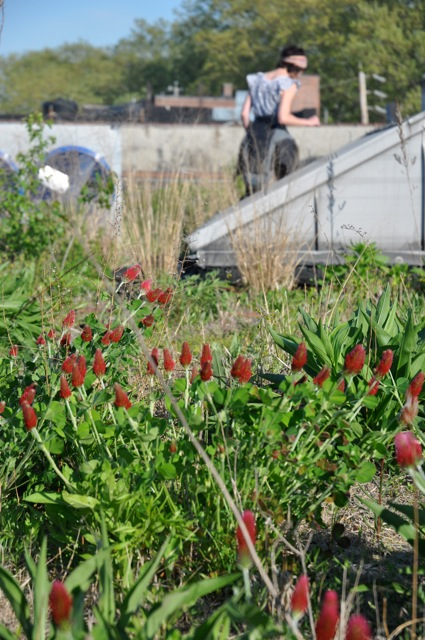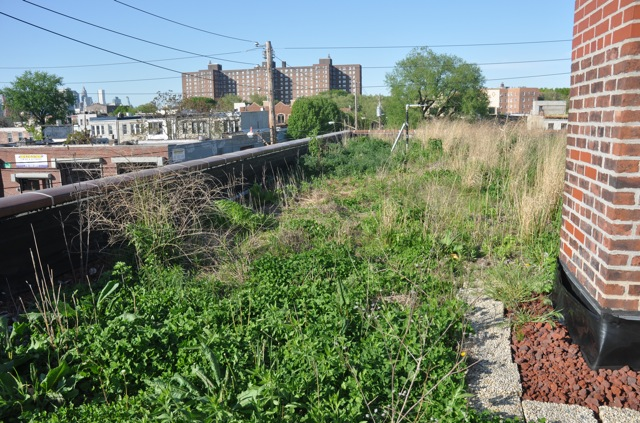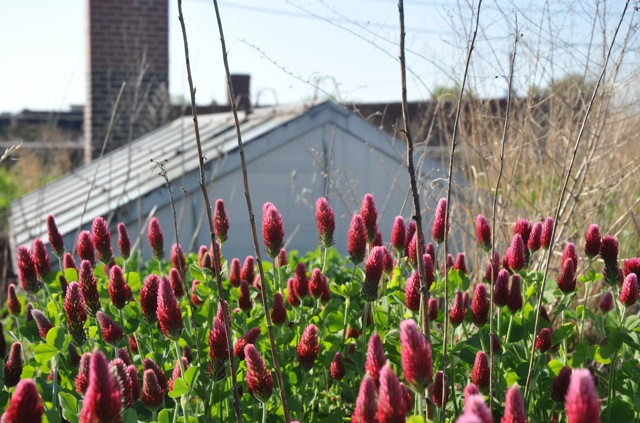 Crimson clover blooms on the roof at the Linda Tool factory.Photo: Sarah GoodyearStanding on the barren, cracked sidewalk outside the nondescript brick building that houses the Linda Tool factory in Red Hook, Brooklyn, you would have no idea that there is a verdant meadow three stories above your head.
Crimson clover blooms on the roof at the Linda Tool factory.Photo: Sarah GoodyearStanding on the barren, cracked sidewalk outside the nondescript brick building that houses the Linda Tool factory in Red Hook, Brooklyn, you would have no idea that there is a verdant meadow three stories above your head.
Oh, but there is. And on this ridiculously beautiful spring day, about 20 wildflower enthusiasts — including hippie-ish middle-aged women, hipster-ish young couples, and a trio of European guys in tight jeans — are picking their way through the grass and blossoms on Linda Tool’s green roof. They snap pictures of flowers in bloom and examine a volunteer sapling whose tender new leaves are fluttering in the breeze.
“That’s crimson clover, isn’t it?” says one bespectacled man, pointing to a colorful clump of flowers. A huge camera hangs around his neck. He wears khaki shorts and wide-brimmed safari hat, looking more prepared for the trails of the Catskill Mountains than the streets around the Red Hook housing projects, which loom a couple of blocks to the north.
“Yes, it’s not a native,” says Paul Mankiewicz of the Gaia Institute, somewhat sheepishly. “But it’s beautiful.”
Mankiewicz was leading the rooftop tour as part of NYC Wildflower Week, an annual event that looks to connect the city’s residents with the nature that persists, against the odds, all around them. Organizers offer 45 tours of wildflower habitat in all five boroughs — “53,000 acres of open space” the website boasts.
 The Red Hook housing projects are visible to the north, as is the distant skyline of Lower Manhattan.Photo: Sarah GoodyearThe 12,500-square-foot Red Hook rooftop — which looks out onto a parking lot full of schoolbuses, an abandoned building, and a huge Ikea store — has got to be one of the more unusual Wildflower Week venues. But Mankiewicz, who designed it, thinks spaces like this should be a lot more common. He says that Linda Tool’s owner, Mike DiMarino, “is an amazing sort of person. He wanted to make his tool business as green as he could.”
The Red Hook housing projects are visible to the north, as is the distant skyline of Lower Manhattan.Photo: Sarah GoodyearThe 12,500-square-foot Red Hook rooftop — which looks out onto a parking lot full of schoolbuses, an abandoned building, and a huge Ikea store — has got to be one of the more unusual Wildflower Week venues. But Mankiewicz, who designed it, thinks spaces like this should be a lot more common. He says that Linda Tool’s owner, Mike DiMarino, “is an amazing sort of person. He wanted to make his tool business as green as he could.”
And so DiMarino secured grant funding for construction of a green roof and contacted Mankiewicz, who is something of a green roof evangelist. Mankiewicz’s long-fingered hands are rough and weathered from years of outdoor labor, and he often lays one on his heart when speaking, as if in emphasis. He has been doing this work since the 1980s — building a greenroof and weather station for a school in the Bronx, developing plans for wetland restoration in the East River, collaborating on an “urban farm” art project.
 Paul Mankiewicz.Photo: Sarah GoodyearThe basis for all his projects is a patented super-lightweight soil medium that incorporates recycled polystyrene foam and compost. Much of the styrofoam comes from packing materials discarded at the city’s Fulton Fish Market. “You’re standing on the waste product of the city of New York,” he says, as the clover nods in the breeze. “And it looks a lot better than the Fresh Kills landfill. I think it looks a lot better than most things.”
Paul Mankiewicz.Photo: Sarah GoodyearThe basis for all his projects is a patented super-lightweight soil medium that incorporates recycled polystyrene foam and compost. Much of the styrofoam comes from packing materials discarded at the city’s Fulton Fish Market. “You’re standing on the waste product of the city of New York,” he says, as the clover nods in the breeze. “And it looks a lot better than the Fresh Kills landfill. I think it looks a lot better than most things.”
Not only does the roof look good, it does good. By lowering the temperature around the tool factory’s HVAC system, it reduces cooling costs by a third. It captures more than 90 percent of rainwater that falls on it, virtually eliminating runoff — an arrangement that figures into the city’s stated strategy to reduce sewer overflow with green, rather than gray, infrastructure. The tool factory, a spotless facility that manufactures aerospace parts among other things, will also be able to recycle the (clean) water it uses to cool its precision laser-cutting machines by pumping it up to the roof.
And the mix of vegetation, which includes narrow-leaved goldenrod and swamp milkweed, also provides habitat for birds, bees, and butterflies. Unlike the more common, German-style roofs that are planted with only with sedums, this one is an ecosystem unto itself. The grasses grow chest-high by midsummer. Ten beehives will be going up on the roof soon as well.
“We need spaces for the creatures that support the rest of us,” said Mankiewicz. He surveyed the roof with a satisfied expression. “I think it looks better in green than in black.”


